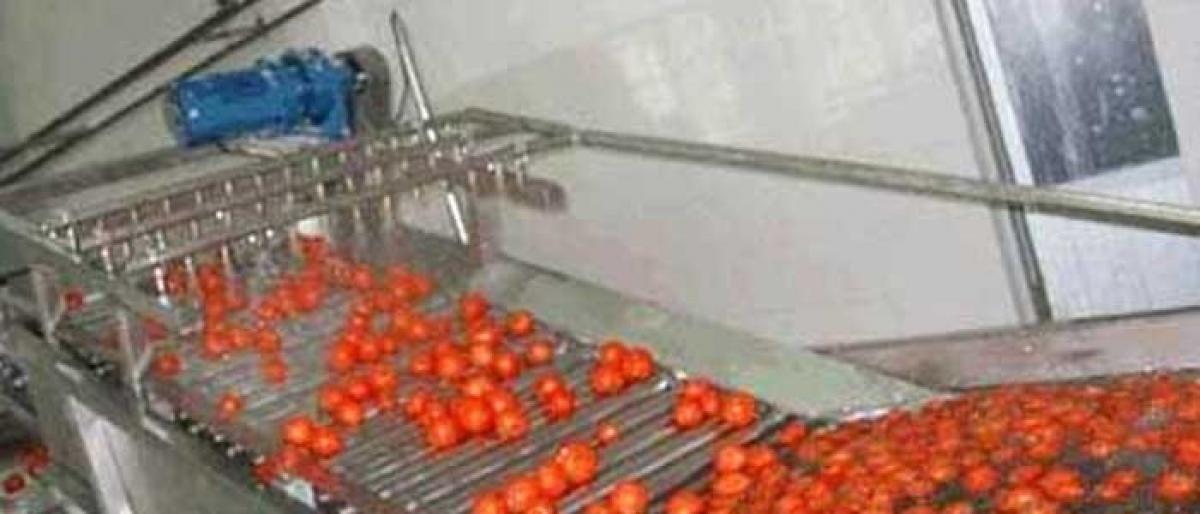Live
- Horoscope Today: Astrological Prediction November 6, 2024 for All Zodiac Signs
- GAIL clocks net profit of Rs 2,672 crore in Q2
- Dubai Fitness Challenge is Here!
- Sr Men's National Hockey: Delhi, Karnataka, Bengal, A.P. win group matches on Day 2
- ‘Nation is proud of you’: West Bengal Guv to GRSE on laying keels of two NGOPVS
- KLH Bachupally Campus Promotes Unity Through Community Initiatives
- Kirttane, Kapadia bag golden double as India wins 14 medals in Asia Pickleball Games
- IDFC FIRST Bank leads the way in revolutionising real-time tracking of money sent abroad through Swift GPI
- Gurugram: 11 projects of GMDA worth Rs 249.77 crores approved
- Samsung R&D Institute, Bangalore Sets Up a State-of-the-Art Linguistics Lab focused on Artificial Intelligence and Machine Learning, Jointly with Garden City University, Bangalore
Just In

How primary processing activity in Food Policy is mouth watering in respect of subsidy? What confusion prevails around this? Read on. Andhra Pradesh Food Processing Society (APFPS),
How primary processing activity in Food Policy is mouth watering in respect of subsidy? What confusion prevails around this? Read on. Andhra Pradesh Food Processing Society (APFPS), the nodal agency for implementing Food Policy 2015-20, conceptualised a scheme to create effective backward linkages through setting up of processing and preservation facilities at village level to enhance shelf life of perishable produces.
Due to inadequate godowns, a lot of perishable products are wasted. To provide rural infrastructure, the “Scheme of Primary Processing Centers / Primary Collection Centers” was designed.
APFPS has invited applications for the scheme and the last date is 31st Jan, 2018. The mandatory requirement for eligibility is one acre of landholding in a village, either own or leased. Second is the activity should relate to primary processing, connected with produce such as: fruits, vegetables, grains and pulses, dairy products, meat and poultry etc.
The confusion is on the compliance of second condition.
Both the terms ‘Primary Processing’ and “Secondary Processing,” are neither defined in Food Policy 2015-20 nor detailed in Scheme. In their absence, there is a lot of confusion to entrepreneurs. The stake is very high as subsidy eligibility for primary processing activity is 50% of project cost while subsidy is only 25% for secondary processing.
Every entrepreneur tries to claim the activity proposed to be launched as primary processing. What is primary processing activity and how it differs from secondary processing? Primary food processing is an economic activity within the food supply chain, which focuses on first- stage processing of agricultural raw materials. During the secondary processing, the outputs of the primary food processing industry are further processed into a wide range of processed foods and other products.
Primary processing is carried out after foods are harvested to prepare them fit for consumption or turn them into other products. Primary processing normally starts and ends with the same product, involving a range of processes like weighing, transportation from farm, sorting, cleaning, destoning, grading, moister removing, milling and packing. The physical form changes very little in some cases.
A few examples for clarity. Pulses, after harvest, contain a lot of impurities. If pulses are cleaned through sieving (removing foreign materials), destoning (taking out small stones out), grading (based on quality) and reducing moister through mechanical means (solar drying may not be sufficient), value addition is created.
Even after the green grams are split for better utility, still it is primary processing as no new ingredient is added. The original form has not changed much. Coconut is collected from farm and fibre removed for coir industry. Coconut shell powder suits needs of paints industry. Coconut water and copra are sold. No new ingredient is added in the process.
The APFPS announced 50% subsidy for maize and coconut projects, at a maximum of Rs 2.5 crore. Indeed, mouth-watering as there is no real complex processing activity. Subsidy on primary processing gives a real boost to locate dry and cold storage in villages, a conditional requirement. Convenience too, no godown size is stipulated leaving to viability.
Basically, primary processing is the initial processing concerned with cleaning, sorting/grading and storing either in dry godown or cold storage to preserve quality with value addition. Size reduction/trimming becomes necessary in case of vegetables which also qualify under the scheme.
So long as no other ingredient is added to original product and only the original product undergoes changes in the process, the activity is primary processing. Once some other ingredient/s is added to original product and form changes substantially altogether to become a new product, then it is secondary processing.
Organic jaggery manufacturing through non-traditional methods is primary processing. After sugar cane collection, attached dirt and leaves are removed to make qualitatively fit for juice extraction. There are only three processes – extraction, clarification and concentration – without using any toxic and harsh chemicals.
It is derived from the process of evaporation of raw sugarcane juice, without separating the molasses to retain rich nutritional values. Similar to coconut project, nothing is added to the original organic sugar cane except boiling extracted juice and later cooling to form into blocks. Organic jaggery is a natural sweetener.
Traditional jaggery manufacturing is not eligible under the scheme. When sugar cane is made into sugar with mixture of other ingredients, it is secondary processing. APFPS should define both primary processing and secondary processing with as many examples as possible for each commodity for removing confusion and creating transparency in the ‘Ease of Doing Business.”
By: C Rama Gopal
(Writer is Agro Processing Consultant, Vizianagaram)

© 2024 Hyderabad Media House Limited/The Hans India. All rights reserved. Powered by hocalwire.com







